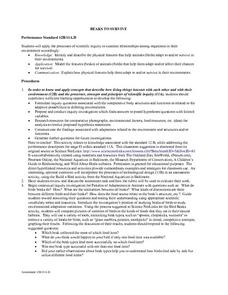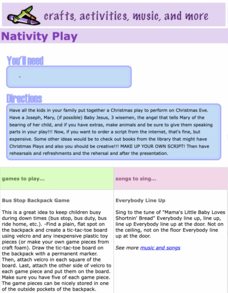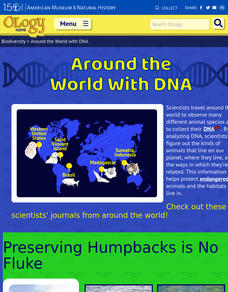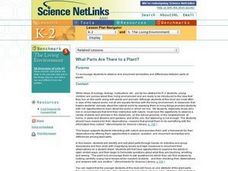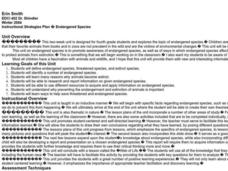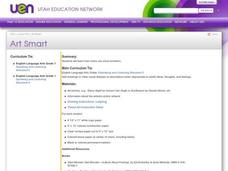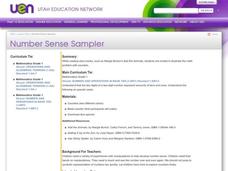Curated OER
Too Two To
For this word usage worksheet, students read the sentences in each paragraph and determine which form of to/two/too should be used to complete the sentence.
Curated OER
Life on the Edge
Students participate in a variety of activities about endangered animals. They read books, watch videos, and, in pairs, choose an endangered animal to research. They create a 2 slide presentation to be compiled into a class slide show.
Curated OER
Beaks To Survive
High schoolers discuss and identify the types of adaptations that are made by different organisms in order for them to survive. In groups, they describe the features of beaks and discuss how it affects their chances for survival. They...
Curated OER
Apostrophes
In these apostrophes worksheets, students complete 4 sets of activities for apostrophes. Students fill in the blanks with contractions, write sentences with contractions, find missing apostrophes, and add apostrophes to the paragraphs.
Curated OER
Cool Math
Students benefit from the correctly selected book for a specific math concept. In this book selection lesson, students are given a list of books related to specific math concepts. Students' ages can range from pre-school to fifth grade.
Curated OER
Time Problems (Half Hours)
In this time problems worksheet, students read the eight word problems about telling time. Students list the answers by half hours.
Curated OER
Nativity Play
Students participate in a play. In this Christmas lesson, students act out the Nativity. A game, a song, a craft, and a recipe are all included with the lesson.
Curated OER
Categories
In this Language Arts worksheet, students determine a word from each of five categories that begin with the letters D, L, A, and C. The categories include types of pets and zoo animals.
American Museum of Natural History
Around with World with DNA
A mammalogist, ornithologist, ichthyologist, and a conservation geneticist share their work and their hopes that their research will help protect and save endangered species and their habitats.
Curated OER
What Parts Are There to a Plant?
Learners identify and sort plant parts through hands-on activities and group discussions and then work with magnifying lenses and tape measures to document their observations on a student sheet.
Curated OER
Camel Container: Ceramics
Play with clay while building finger dexterity and important sculpting techniques. Learners make camel containers while they practice throwing and molding clay. Fun camel facts make this an interdisciplinary art lesson plan.
Curated OER
Bottled Water Ban
Convenience, taste, portability ... what's not to love about bottled water? Apparently, a lot. Scholars analyze the four main arguments supporting and opposing the sale of bottled water. They explore the health, environmental, and...
Curated OER
Number Song
Students sing a song (to the tune of The Twelve Days of Christmas) that helps reinforce their counting skills.
Curated OER
Endangered Species
Fourth graders investigate endangered species to discover reasons for the extinction. Resources are examined to determine preventive measures for the endangerment. The unit contains four lessons.
Curated OER
Pio, Pio, Que Frio
Students investigate the characteristics of living things. They determine that different organisms have different needs and describe and compare them. They draw and verbally respond about their favorite animal.
Curated OER
Listen and Draw
Young scholars use their visualizing and interpreting skills to produce original writings and drawings. First, they listen to an adaptation of William Clark's description of the sage grouse. They form mental images that they translate...
Curated OER
Field Trips Can Inspire Students to Write Creatively
Fieldtrips can lead to a variety of writing experiences for students.
Curated OER
Number Sense Sampler
First graders read a variety of stories containing mathematical word problems. They illustrate the math problems with manipulable counters.
Curated OER
Vertebrates are Cool!
Students conduct research on various vertebrates. They read the eBook 'Vertebrates,' select a vertebrate, conduct research, and create an eBook with one photo about their chosen vertebrate.
Curated OER
Spineless - YES... Helpless - NO!
Students distinguish between invertebrate and vertebrate organisms while examining the zoological classes of a number of invertebrates. They illustrate a food web of these organisms and investigate the impact of humans on the oceanic...
Curated OER
Characteristics of Snakes and Turtles
Students compare and contrast snakes and turtles, then fill out an information sheet.
Curated OER
Animal Alphabet Book
Students identify each letter of the alphabet. They listen as the teacher reads an animal alphabet picture book. Students listen to the alphabet song. They create their own movements for the alphabet song. Students are asked to name...
Curated OER
Egg Carton Stories
Students create stories with better structure when they are able to focus on its characters, setting, and plot. Teacher creates settings, character, and problem cartons with information written on strips of paper.




